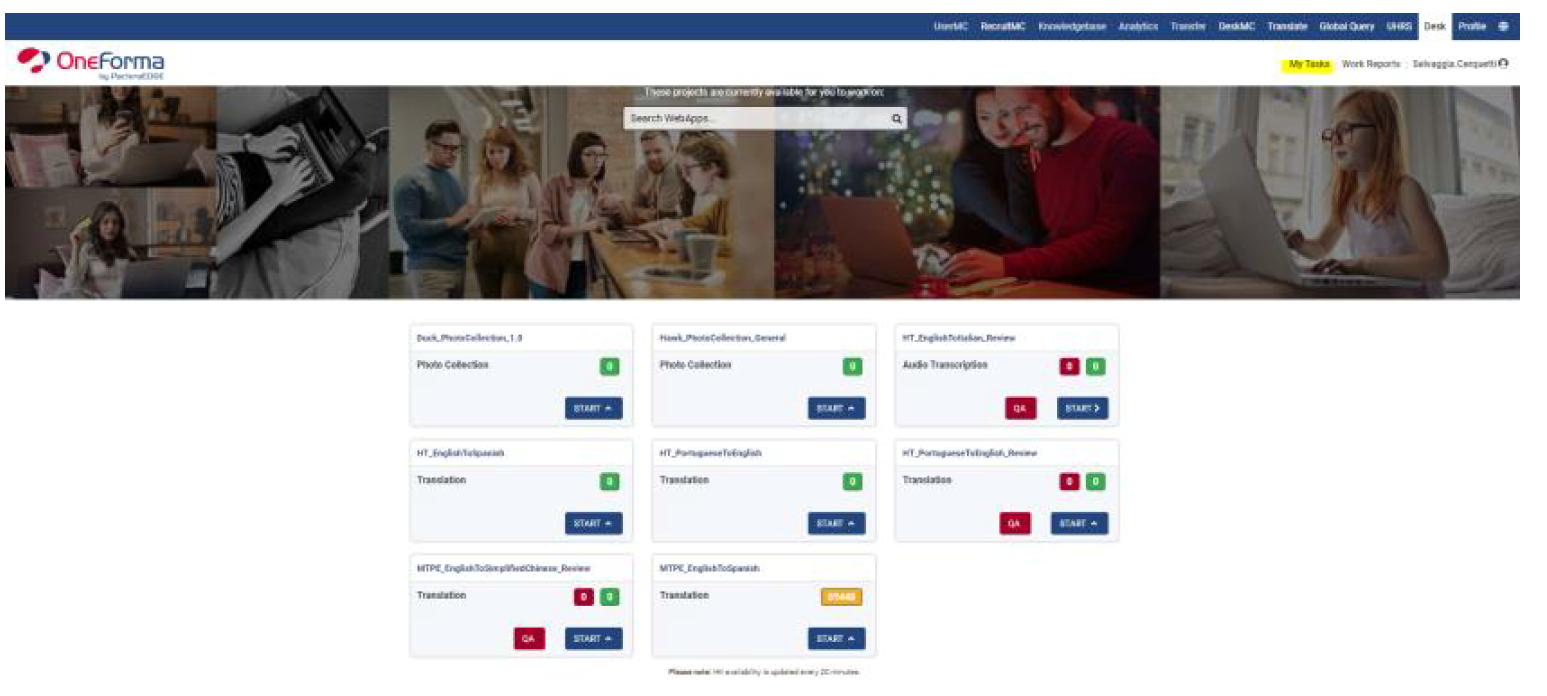User Tools
Sidebar
isaac_project:en:human_translation_instructions_v311:4_webapp_guidelines
This is an old revision of the document!
WEBAPP GUIDELINES
DESK ACCESS: go to https://desk.oneforma.com/ and login with your OneForma credentials. In “My Tasks” there is a list of webapps that have been assigned to you.

WEBAPP ACCESS: For translation, go to Actions > Start.
For review, go to QA actions > QA.
RADIO BUTTONS: As mentioned, you will be presented with 6 checkboxes about the source text in the webapp:
Wrong language in source: mark this if the text is completely in another language (not the
announced source language).
✘ Do not check this box if the words in other language are borrowed, shared, or common
words in the source and target languages.
Garbled text in source: mark this if the source text is completely garbled (a series of random
characters like: “jknjknkjnknknn”) or contains programming language (javascript, html, etc). If
only a part of the source is garbled, do not click the “Garbled” checkbox, leave the garbled
part as it is in source and translate the rest of the sentence as you would normally do.
Nonsensical source: mark this if the source text is completely nonsensical, and then provide
a literal word by word translation. If only a part of the source is nonsensical, but the rest of
the sentence is fine, translate the nonsensical part literally and the rest of the sentence as
you would normally do. Do not describe nonsensical words.
Typos or Spelling errors in source: mark this if the source contains grammar or spelling
mistakes but the meaning remains clear, and then provide a fluent translation - do not
replicate the ungrammatical constructs or misspellings into the target language. Also
disambiguate abbreviations (Ex. 'how r u → cómo estás').
More than 1 language in source: mark this if there is any other language present in the
source text, apart from the intended one. This includes borrowed, shared or common words
from other languages
None apply: Mark this checkbox if none of the other ones apply to the text.
To revert any of these selections, click the “clear selection” button.
NOTE: if the source string just contains a symbol or a punctuation like like “>” or “[ [ ] ]”, this
does not fall into any of the above scenarios. This should be left as in the source for T1 and
T2 should be omitted.
HT WEBAPP FOR TRANSLATORS: for projects that require 1 translation, you will see
only one textbox per source string. For projects that require 2 translations, it will be the same
and you will still see only one textbox per source string, so the same hit can be translated
by two different resources. The first time you translate a hit you will have the following layout,
so you just need to provide the Translation1 in the Proposed translation textbox.
If you translate a sentence that has been previously translated by another resource or by
yourself (because you can translate one sentence and after some time get the same source
to translate), it means you need to provide the Translation2 (if possible) and you will see the
following layout. In this case the Translation1 from first translator will be blocked and can
only be used for reference. You need to provide a Translation2 in the Proposed
Translation textbox.
Following with the general guidelines it’s forbidden to provide an identical or very similar
Translation2: you won’t be able to submit it and you’ll get a pop-up message warning about
it.
HT WEBAPP FOR REVIEWERS: for projects that require 2 translations, you will see 2
textboxes for the same source, the upper one with Translation1 and the lower one with
Translation2 (which may be empty if the second translator didn’t provide a Translation2).
Read the source carefully, review the 2 different translations following the provided linguistic guidelines and implement any change (if needed) in the corresponding text box. If the reviewed translations (either 1, 2 or both) have errors, select the applicable error category from the drop down menu. Error categories that can be selected are:
For cases when the reviewer works on a 2nd round of QA (when additional hits of under-
performing translators are sent out to QA), only the translation box coming from the under-
performing translator will be editable for review. For example, here we need to review only
the Translation1. The “Alternative translation provided” is the Translation2 coming from a
translator who doesn’t need to be reviewed. So you have to review only the Translation1
considering that it will be associated with the indicated Translation2 (don’t change it to
something too similar or the system will not allow you to submit).
isaac_project/en/human_translation_instructions_v311/4_webapp_guidelines.1700062228.txt.gz · Last modified: 2023/11/15 15:30 by sergio
Except where otherwise noted, content on this wiki is licensed under the following license: CC Attribution-Share Alike 4.0 International









